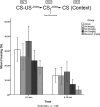Extract and Active Principal of the Neotropical Vine Souroubea sympetala Gilg. Block Fear Memory Reconsolidation
- PMID: 31956309
- PMCID: PMC6951415
- DOI: 10.3389/fphar.2019.01496
Extract and Active Principal of the Neotropical Vine Souroubea sympetala Gilg. Block Fear Memory Reconsolidation
Abstract
Background: Souroubea sympetala Gilg. is a neotropical vine native to Central America, investigated as part of a targeted study of the plant family Marcgraviaceae. Our previous research showed that extract of S. sympetala leaf and small branch extract had anxiolytic effects in animals and acts as an agonist for the GABAA receptor at the benzodiazepine binding site. To date, the potential effects of S. sympetala and its constituents on reconsolidation have not been assessed. Reconsolidation, the process by which formed memories are rendered labile and susceptible to change, may offer a window of opportunity for pharmacological manipulation of learned fear. Here, we assessed the effects of S. sympetala crude extract and isolated phytochemicals (orally administered) on the reconsolidation of conditioned fear. In addition, we explored whether betulin (BE), a closely related molecule to betulinic acid (BA, an active principal component of S. sympetala), has effects on reconsolidation of learned fear and whether BE may synergize with BA to enhance attenuation of learned fear. Method: Male Sprague-Dawley rats received six 1.0-mA continuous foot shocks (contextual training). Twenty-four hours later, rats were re-exposed to the context (but in the absence of foot shocks). Immediately following memory retrieval (recall), rats received oral administration of S. sympetala extract at various doses (8-75 mg/kg) or diazepam (1 mg/kg). In separate experiments, we compared the effects of BA (2 mg/kg), BE (2 mg/kg), and BA + BE (2 mg/kg BA + 2 mg/kg BE). The freezing response was assessed either 24 h later (day 3) or 5 days later (day 7). Effects of phytochemicals on fear expression were also explored using the elevated plus maze paradigm. Results: S. sympetala leaf extract significantly attenuated the reconsolidation of contextual fear at the 25- and 75-mg/kg doses, but not at the 8-mg/kg dose. Furthermore, BA + BE, but not BA or BE alone, attenuated the reconsolidation of learned fear and exerted an anxiolytic-like effect on fear expression.
Keywords: Sin Susto; Souroubea sympetala; betulin; betulinic acid; fear memory; reconsolidation.
Copyright © 2019 Murkar, Cayer, James, Durst, Arnason, Sanchez-Vindas, Otarola Rojas and Merali.
Figures








References
-
- Arnason T., Hebda R. J., Johns T. (1981). Use of plants for food and medicine by Native Peoples of eastern Canada. Can. J. Bot. 59, 2189–2325. 10.1139/b81-287 - DOI
LinkOut - more resources
Full Text Sources

